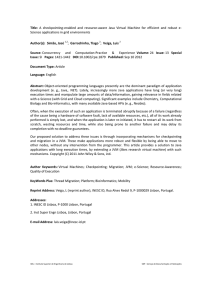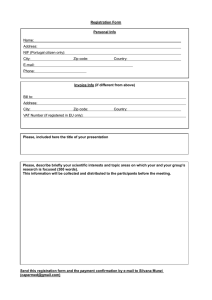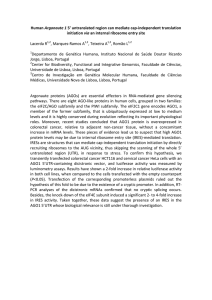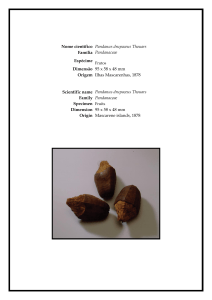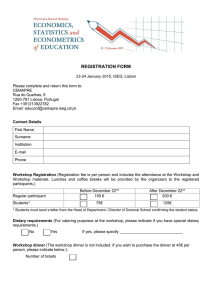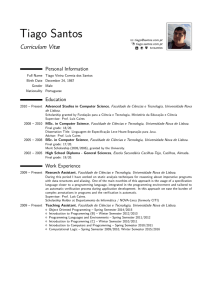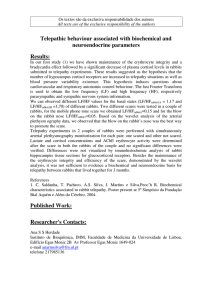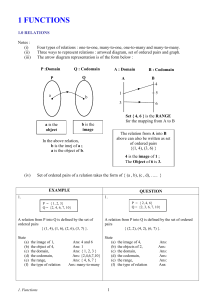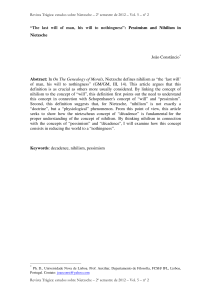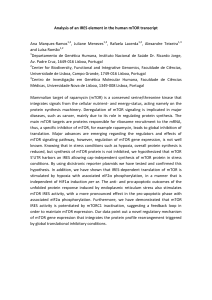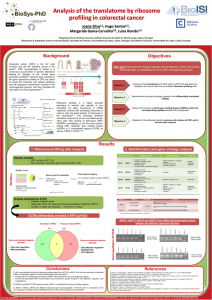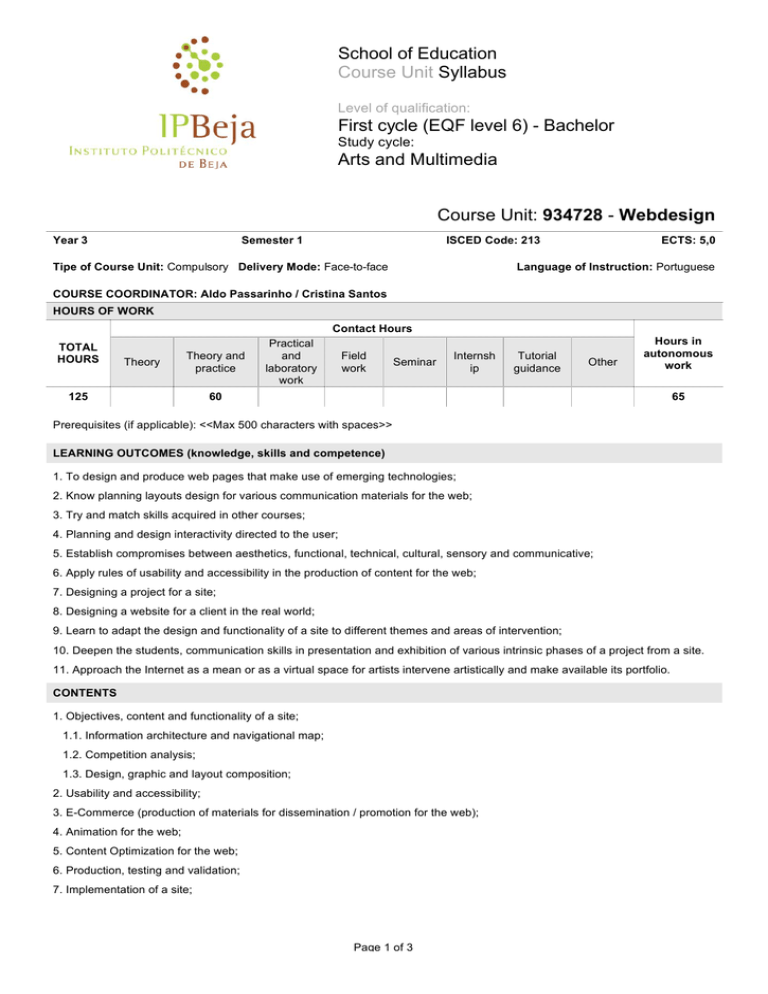
School of Education
Course Unit Syllabus Level of qualification:
First cycle (EQF level 6) - Bachelor
Study cycle:
Arts and Multimedia
Course Unit: 934728 - Webdesign
Year 3
Semester 1
ISCED Code: 213
Tipe of Course Unit: Compulsory Delivery Mode: Face-to-face
ECTS: 5,0
Language of Instruction: Portuguese
COURSE COORDINATOR: Aldo Passarinho / Cristina Santos
HOURS OF WORK
Contact Hours
TOTAL
HOURS
Theory
Theory and
practice
125
Practical
and
laboratory
work
Field
work
Seminar
Internsh
ip
Tutorial
guidance
Other
Hours in
autonomous
work
60
65
Prerequisites (if applicable): <<Max 500 characters with spaces>>
LEARNING OUTCOMES (knowledge, skills and competence)
1. To design and produce web pages that make use of emerging technologies;
2. Know planning layouts design for various communication materials for the web;
3. Try and match skills acquired in other courses;
4. Planning and design interactivity directed to the user;
5. Establish compromises between aesthetics, functional, technical, cultural, sensory and communicative;
6. Apply rules of usability and accessibility in the production of content for the web;
7. Designing a project for a site;
8. Designing a website for a client in the real world;
9. Learn to adapt the design and functionality of a site to different themes and areas of intervention;
10. Deepen the students, communication skills in presentation and exhibition of various intrinsic phases of a project from a site.
11. Approach the Internet as a mean or as a virtual space for artists intervene artistically and make available its portfolio.
CONTENTS
1. Objectives, content and functionality of a site;
1.1. Information architecture and navigational map;
1.2. Competition analysis;
1.3. Design, graphic and layout composition;
2. Usability and accessibility;
3. E-Commerce (production of materials for dissemination / promotion for the web);
4. Animation for the web;
5. Content Optimization for the web;
6. Production, testing and validation;
7. Implementation of a site;
Page 1 of 3
8. Use of free platforms available on the web (blogger, wordpress and wix).
DEMONSTRATION OF THE CONTENTS COHERENCE WITH THE COURSE UNIT’S LEARNING OUTCOMES
1. Objectives, content and functionality of a website (Objective 1, 2, 3, 4, 5, 7, 8, 9, 10);
1.1. Information architecture and navigational map;
1.2. Competition analysis;
1.3. Design, graphic and layout composition;
2. Usability and accessibility (objective 4, 5, 6);
3. E-Commerce (production of materials for dissemination / promotion for the web) (objective 2, 3, 4, 5);
4. Animation for the web (Objective 2 and 3);
5. Content Optimization for the Web (objective 2, 11);
6. Production and validation test (objective 1, 3, 4, 5, 7, 11);
7. Implementation of a site (Objective 1, 7, 10, 11);
8. Use of free platforms available on the web for building a portfolio (blogger, wordpress and wix) (Objective 1, 2, 3, 4, 5, 6, 11).
TEACHING METHODOLOGIES
In this course the exhibition, demonstrative and interrogative methods are used; are made of short exercises, complementary to
the main project evaluation UC (design of a website in real context);
Methodology:
1. Lectures and experimental classes of understanding these concepts taught;
1.1. View countless examples of reference sites;
1.2. Critical analysis of existing web sites;
2. Research and literature references in the web design field;
3. Practical development lessons of work and monitoring by the teacher;
4. Presentation and discussion of the work performed.
4.1. Debate and visualization group of works presented.
5. Direct contact between students and the chosen client for website development.
DEMONSTRATION OF THE COHERENCE BETWEEN THE TEACHING METHODOLOGIES AND THE LEARNING
OUTCOMES
1. Lectures and experimental classes of understanding these concepts taught (Objective 1, 2, 3, 4, 5, 6, 7, 9);
1.1. View countless examples of reference sites;
1.2. Critical analysis of existing web sites;
2. Research and literature references in webdesign area (Objective 2, 4, 6, 7, 9, 11);
3. Practical development lessons of work and monitoring by the teacher (Objective 1, 2, 3, 4, 5, 6, 7, 9, 11);
4. Presentation and discussion of the work performed (Objective 5, 7, 10).
4.1. Debate and visualization group of works presented.
5. Direct contact between students and the chosen client for website development (Goal 8 and 9).
In this course, it is intended that students have knowledge-based theoretical and technical foundations, applied in solving
practical exercises proposed by the teacher. Objective is both a conscious knowledge of what is the activity of a web designer in
the real world.
In this way, students propose to the teacher, conduct a site for a company / institution from any area (art, education, culture,
trade, sports, catering, etc.) in the region where they live or study. The proposed site can be related to a company that has not
yet online presence or has a website already done, but that students propose replacing. Prior to the site, are carried out
exercises that help students acquire theoretical skills, aesthetic, functional and basic technical compliance with all of the stages
Page 2 of 3
involved in the development of materials for the web.
It is intended as well to add the concepts of usability and accessibility planning interfaces on web pages, ensuring that the end
user attains its objectives intuitively and emphasize the importance of design in the planning of a site, so that the internet is
stated as a powerful marketing tool in the business.
EVALUATION METHODS
Realization of a project for a website and exercises that contribute to acquiring skills and prepare students for the practice of
webdesign. The work for evaluation is performed during and outside of class context, according to the internal school
regulations.
MAIN BIBLIOGRAPHY
COELHO, P. (2007). Como criar Páginas Web. Lisboa: FCA.
FIGUEIREDO, B. (2004). Web Design – Estrutura, concepção e produção de sites Web. (2ª ed.) Lisboa: FCA.
GARRETT, J. J. (2003). The Elements of User Experience. New York: AIGA- American Institute of Graphic Arts.
GREENE, R. (2004). Internet Art (World of Art). London: Thames and Hudson.
JACKSON, C. (2008). Flash + After Effects. Oxford: Focal Press.
LYNCH, J. P. e HORTON, S. (2001). Guia de estilo da web – Princípios básicos de design para a criação de websites.
Barcelona: Editorial Gustavo Gili.
NIELSON, J. (2000). Designing Web usability. Indianapolis: New Riders Publishing.
OLIVEIRA, H. (2011). Dreamweaver CS5.5 & CS5 – Curso Completo. Lisboa: FCA.
TRIBE, M. e REESE, J. (2006). New Media Art. Köln: Taschen.
WEINMAN, L. (1998). Design gráfico na Web. Como preparar imagens e mídia para a Web. São Paulo: Quark do Brasil.
WIEDEMANN, J. (ed.). Web Design Studios 2. Köln: Taschen.
Year of implementation: 2011/2012 | Date of approval by the Technical-Scientific Board: 2015-09-01
Page 3 of 3


